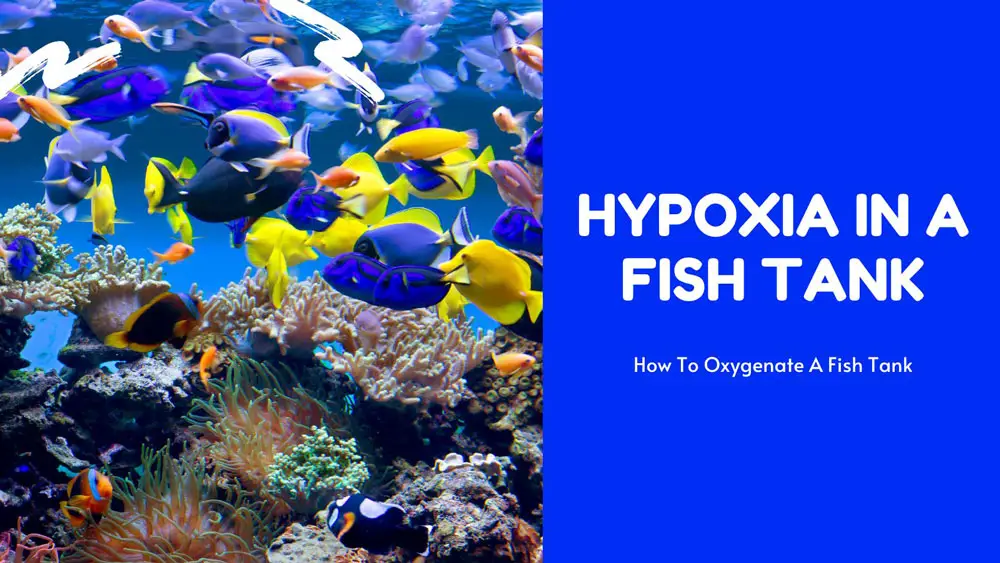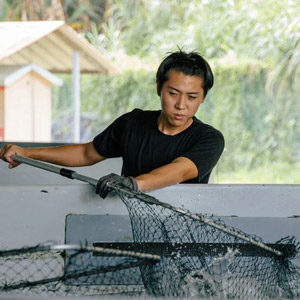Often pet fish owners don’t give much thought to dissolved oxygen (DO) levels in a fish tank, and I used to be one of them. Why should we bother? After all, we already have a filter working there 24/7.
That’s actually a good question, but it’s a bit more complicated.
It is true that hypoxia is less common than ammonia toxicity and nitrite toxicity in fish tanks, but it can also kill your fish, especially with large species that are sensitive to low oxygen levels.
Fortunately, this guide will clear everything up. You’ll learn everything you need to know about hypoxia in a fish tank, how to oxygenate a fish tank, and what you can do in emergencies.
Do Fish Need Oxygen?
To find out the optimal amount of oxygen in your tropical fish tank, let’s start with the basics.
Do fish really need oxygen? The answer is yes; humans and fish both require oxygen to survive. It’s just as important for the survival of your fish as food and clean water.
With most fish, they absorb the dissolved oxygen from the water through their gills behind the head on each side. Their fairly large gills have thousands of small blood vessels, which pick up dissolved oxygen and release carbon dioxide underwater.
But some species, such as bettas, gouramis, and many labyrinth fish, develop a labyrinth organ that functions sort of like a lung, which allows them to breathe air at the surface of the water.
Hypoxia also occurs in the wild; it has been linked to fish schooling behavior change [1] and disease outbreaks [2].
Where Do Fish Get Oxygen from In Your Aquarium?
No matter what type of aquarium you have, the primary source of oxygen in a fish tank comes from the gas exchange, which takes place at the water’s surface. This is the main reason why many fishkeepers decide to go with topless tanks.
Aquatic plants are another excellent source of oxygen in your aquarium. During the day, they use carbon dioxide (CO2) and water to undergo photosynthesis and produce oxygen. However, when the lights go off, they stop producing oxygen. Meanwhile, the plants start to “breath” and may compete with your fish for oxygen in the water. Therefore, the DO is higher in the late afternoon than early morning [3].
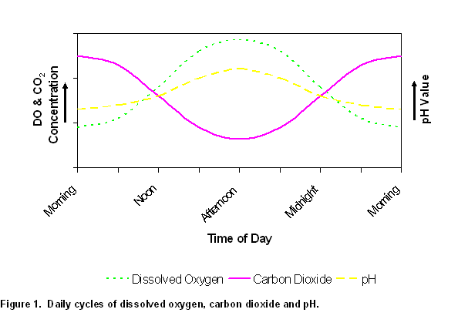
At this point, you may wonder how much oxygen is needed in your aquarium. The answer to that question depends on the following factors.
What Factors Affect Oxygen Level in a Fish Tank?
First, the amount of dissolved oxygen in the aquarium water is determined by your setup, stocking level, and individual species of fish, including:
- Tank Dimensions: Wider, shallow tanks often do better in terms of oxygen levels than tall, narrow tanks because they provide more water surface. For example, a 75 gallons aquarium offers more benefits than a 55-gallon tank because of its extra width.
- Plants: Live plants will help increase oxygen levels in your aquarium.
- Lighting: Too much aquarium lighting runs the risk of algae blooms, which can consume all the available oxygen in your tank.
- Aeration System: A good aeration system can greatly increase DO levels in an aquarium.
- Stocking level: Overstocked aquariums need more oxygen than lightly stocked aquariums.
- Species: What kind of fish you have in your aquarium also matters. For instance, labyrinth fish, such as gouramis, bettas are known for being able to tolerate low oxygen levels. On the other hand, the Oscars need water that is rich in oxygen to stay healthy. In addition, fast-swimming fish that prefer strong currents also require high oxygen levels.
- Fish Size: Oxygen needs vary among fish sizes, with larger fish typically requiring more oxygen than smaller ones. This is also the case for fry and newborns, who require extra oxygen as they develop.
Next, water temperature is an important factor with maximum dissolved oxygen. There is an inverse relationship between them: the warmer the water, the less oxygen it can hold.
It is also essential that you understand the salinity level of your aquarium. Similarly, like temperature, their relationship is inverse: as salinity increases in the water, DO exponentially decreases [4]. This is why saltwater aquariums usually require supplemental oxygenation.
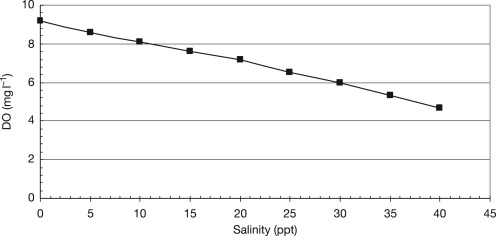
You probably already know that locations with high altitudes will have lower oxygen levels due to the drop in atmospheric pressure. Under greater pressure, water can hold more oxygen. Therefore, fishkeepers living in high-altitude locations should be extra vigilant when it comes to monitoring their aquarium DO levels.
Last but not least, “turbulence” and water movement play a role in aquarium oxygenation. As the water moves, more gas exchange occurs at the water surface. So, if you want to keep your aquarium DO high, ensure an adequate filtration system is in place.
How Much Oxygen Does Your Fish Tank Need?
Any combination of the above factors will influence oxygen levels in your fish tank. As a result, there is no exact number to the question, “how much oxygen do fish need?”
However, it is generally accepted that aquariums should maintain a DO level of 6-8 ppm (parts per million) and an 80-110% oxygen saturation to remain safe for most tropical fish.
Oxygen supersaturation should be avoided, because it can introduce microbubbles inside the fish and cause gas bubble disease (GBD) [5].
How to Test Oxygen Level in Fish Tank?
Most popular aquarium water test kits don’t contain a test for oxygen levels. Electrochemical dissolved oxygen meters are also available but typically have a high price tag. Here is an inexpensive yet accurate alternative to measure oxygen in your aquarium:
No products found.
The entire testing process takes, on average, 10 minutes per test and involves measuring the number of drops from three different bottles, then comparing them to a color chart. Although it sounds tedious, the process is actually quite simple and easy.
Signs of Low Oxygen in Aquarium
Since there is no magic method to detect hypoxia immediately, familiarizing yourself with the early signs of hypoxia might save your fish someday.
- Lethargy
- Labored breathing
- Rapid gill movement
- Difficulty swimming or loss of balance
- Gasping at the surface.
- Gathering near the filter’s outflow
Causes of Hypoxia and How to Avoid
We know that you may already have a few clues on what could be causing the low oxygen levels in your aquarium, but we want to make sure you’ve considered all of the possible causes.
| Causes | Fixes & Prevention |
|---|---|
| Overcrowding | Perform a large water change every day or add an additional filter. |
| Fluctuating water temperatures | Performing a water change with cold water or adding ice cubes |
| Low water movement | Adding an aerator or an additional filter. |
| Dirty tank | Perform a weekly partial cleaning and don’t overfeed |
| Live plants | Increasing the lighting duration in a planted tank |
| Power outage | A battery-powered air pump backup can literally be a life save |
| Dosing medicine | Increasing the water circulation when you use certain chemicals |
| Infested by green hair algae | Manual removal |
Emergency Practices
In extreme cases, when you notice that the fish are gasping for air near the surface of the water, act immediately because hypoxia can be life-threatening to fish. The following fast ways will buy some time to figure out and address the main issue.
Add hydrogen peroxide (H₂O₂)
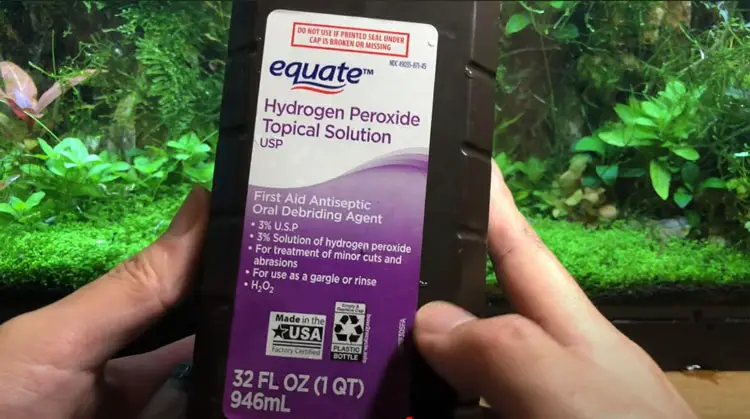
Adding hydrogen peroxide is an effective and safe way to add oxygen to a fish tank without a pump.
Water (H₂O) and hydrogen peroxide (H₂O₂) are both made of the same elements: oxygen and hydrogen. However, the latter has one more oxygen than the former.
When added to the tank, the peroxide solution breaks down to water and extra oxygen. Moreover, there is no residue of any dangerous chemicals left behind.
Two concentrations of hydrogen peroxide are available on the market, 3% and 6%. To utilize the less concentrated 3% solution, mix .07 ounces (2ml) with 2 gallons of water. However, if you choose to use the more powerful 6% solution, only add .03 ounces (1ml) for every 2 gallons of water.
Before adding it to the tank, dilute the required amount by stirring it into 10 times the amount of water.
For instance, if you have a 55-gallon fish tank and are using a 6% hydrogen peroxide solution, you will need (0.03 x 55 = 1.65 ounces) of peroxide. This will need to be diluted with 2 cups (470 ml) of water before adding it to the tank.
Do not give into temptation and overdose; aside from actually stressing your fish, a little extra won’t help at all.
Water Changes
Perform a large water change of at least 50 percent to bring the oxygen level up. Ensure the new water has the same temperature and chemistry.
Backup Aquarium Air Pump
If you live in an area with severe weather, randomly occurring power outages are not uncommon. A home generator is the best way to combat this issue, but if that’s not something you have invested in, a battery-powered air pump will do the trick of keeping your fish tank water circulated during a power outage.
No products found.
Adding Ice Cubes
If the behavior of your fish shows signs of hypoxia due to the rising temperatures, and you can’t handle a water change due to the tank size, adding some ice cubes in a sealed bag to lower the temperature of the water may help. Meanwhile, do check to be sure that your temperature levels remain safe for your fish.
How To Increase Oxygen in a Fish Tank in the Long Run
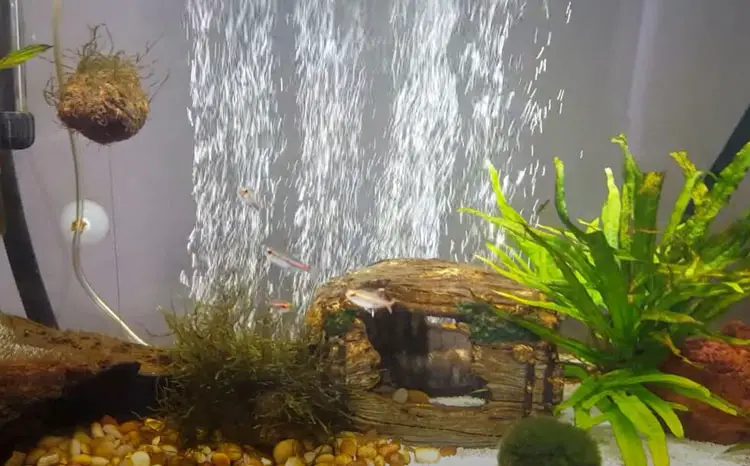
The solutions we mentioned above are great for emergency cases, but prevention is the best solution, as with other aquarium water issues.
Below are some time-tested solutions to improve the oxygen levels in your fish tank. All are easy and guaranteed to work!
Choose a Wide Tank
An aquarium with more surface area allows gas exchange more efficiently. Thus, the oxygen levels in a wider tank are often higher than those of a narrow tank.
Keep Live Plants in the Tank
Growing live plants is a great long-term preventive solution for oxygen-related issues. Not only are they great oxygen boosters, but they also work as natural filters for the aquarium.
Adding an Aerator or Extra Filter
A good filter is a must in any aquarium environment. It helps to keep the water clean and clear, but it also brings oxygen levels up. You might want to consider investing in air bubblers (or airstones) and combining them with a powerful filter for large aquariums.
Regular Water Changes
In addition to keeping your tank clean and healthy, regular partial water changes bring oxygen levels up in the aquarium. Just remember not to change all of the water at once, as it might shock your fish.
How Long Do Fish Can Survive in Hypoxia?
It is only possible to know the species of the fish. Generally, most ornamental fish can survive in hypoxic conditions for about 5 to 24 hours or so without any long-term damage.
Interestingly, one of our well-known fishy friends – goldfish – has a secret superpower: they can produce alcohol to survive in oxygen-depleted ponds for up to five months during the winter [6].
Conclusion
Dealing with hypoxia in the aquarium is something that requires attention and diligence. But with the right knowledge, you can keep your beloved fish safe and healthy.
Keep an eye on the oxygen levels in your tank, use the solutions above to increase it if needed, and have a peaceful time watching your aquarium creatures swim happily!
And as always, if you have any questions or concerns about keeping your aquarium oxygen levels in check, don’t hesitate to ask!
Article Sources:
- The effect of hypoxia on fish schooling [The Royal Society]
- Abdel-Tawwab M, Monier MN, Hoseinifar SH, Faggio C. Fish response to hypoxia stress: growth, physiological, and immunological biomarkers. Fish Physiol Biochem. 2019 Jun;
- Aquarium Water Quality: Dissolved Oxygen [Fdacs.gov]
- What Is The Relationship Between Dissolved Oxygen And Salinity? [Atlas Scientific]
- Gas Bubble Disease (GBD) in Freshwater Fish [TheSprucePets]
- Goldfish go months without oxygen by making alcohol inside cells [NewScientist]
